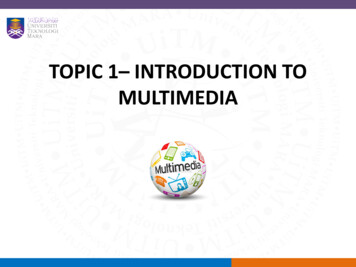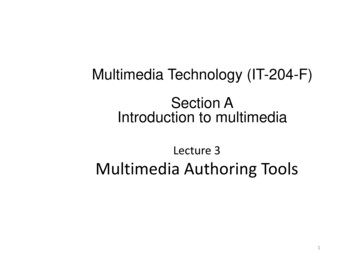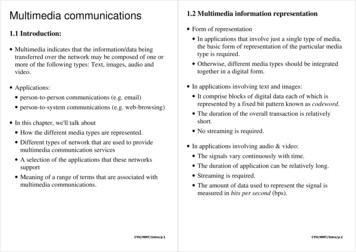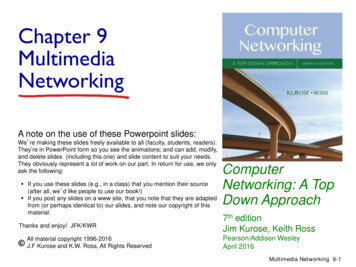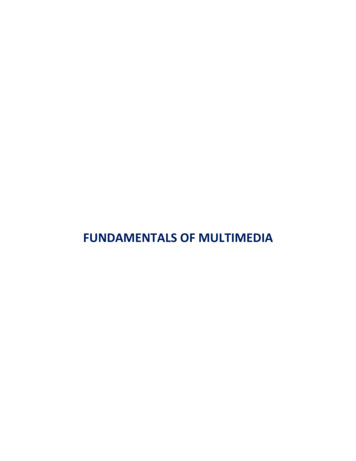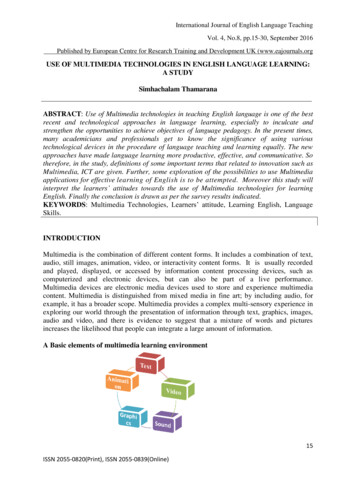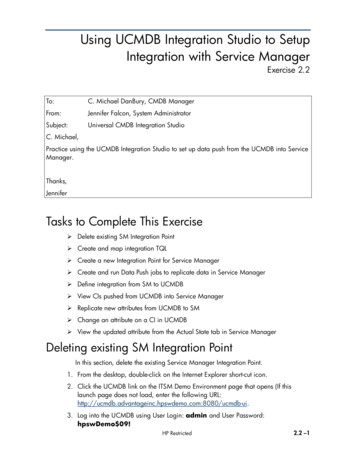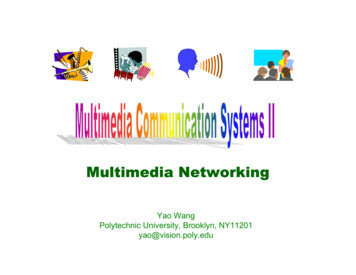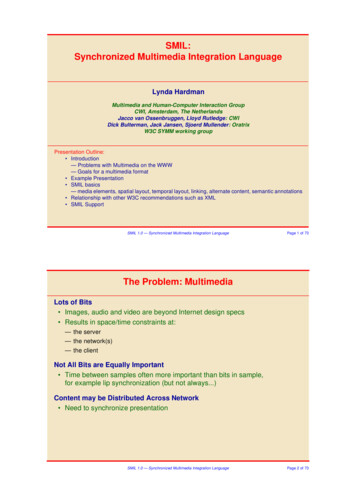
Transcription
SMIL:Synchronized Multimedia Integration LanguageLynda HardmanMultimedia and Human-Computer Interaction GroupCWI, Amsterdam, The NetherlandsJacco van Ossenbruggen, Lloyd Rutledge: CWIDick Bulterman, Jack Jansen, Sjoerd Mullender: OratrixW3C SYMM working groupPresentation Outline: Introduction— Problems with Multimedia on the WWW— Goals for a multimedia format Example Presentation SMIL basics— media elements, spatial layout, temporal layout, linking, alternate content, semantic annotations Relationship with other W3C recommendations such as XML SMIL SupportSMIL 1.0 — Synchronized Multimedia Integration LanguagePage 1 of 73The Problem: MultimediaLots of Bits Images, audio and video are beyond Internet design specs Results in space/time constraints at:— the server— the network(s)— the clientNot All Bits are Equally Important Time between samples often more important than bits in sample,for example lip synchronization (but not always.)Content may be Distributed Across Network Need to synchronize presentationSMIL 1.0 — Synchronized Multimedia Integration LanguagePage 2 of 73
Declarative: the key to Web integrationChoices: Programmed: encode events that display and remove objects— Lingo (Director) (using Shockwave)— Java (Dynamic HTML) Declarative: specify a set of objects and their synchronization— VRML— CWI’s CMIF— INRIA’s Madeus Declarative for basic aspects, extra complexity using programmed.SMIL 1.0 — Synchronized Multimedia Integration LanguagePage 3 of 73Objectives for Web-based MultimediaAdd synchronization capabilities to the WebProvide a declarative language for the Web interoperabilityFormat should be text based so can be edited by hand preferably XML basedSMIL 1.0 — Synchronized Multimedia Integration LanguagePage 4 of 73
SMILSynchronizedMultimediaIntegrationLanguageSMIL is about timing.not just graphics.combining Web resources.in an XML syntaxSMIL 1.0 — Synchronized Multimedia Integration LanguagePage 5 of 73SMILSynchronized Multimedia Integration Language pronounced smile SMIL 1.0 became W3C recommendation on 15th June 1998 SMIL Boston is public draft for next version, last released February 25 2000SYMM group includes CWI, Oratrix - GRiNS authoring environment and player RealNetworks- RealPlayer 7 (G2), time-focussed media type, 3rd party creation tools Microsoft - Internet Explorer 5.5 supports HTML SMILFocus SMIL 1.0 - Multimedia “basics”, adaptive SMIL Boston -“prettier” (animation, transitions),integration with other W3C languagesSMIL 1.0 — Synchronized Multimedia Integration LanguagePage 6 of 73
SMIL as XML MarkupIntegration language Media elements referred to, not includedSMIL is XML Defined with XML DTD Can be hand-authored Declarative language- attribute/value pairs Integrable with XML environmentsRelationship with Other W3C Recommendations Again, SMIL is XML Basic layout isomorphic and replacable with CSS Shares constructs with (X)HTML SMIL Boston “Family” languages enable new SMIL-based XML formatsSMIL 1.0 — Synchronized Multimedia Integration LanguagePage 7 of 73XML (eXtensible Markup Language)Foundation Syntax for all Documentsxxxxxxxxx xxxxxxxx xxxxfilexxxxxxxxxxxxxx xxxxxxxx xxxx xxxxxxxx Document Type Definitions (DTDs)smiltext contentheadmediafilebodylayoutparseqregionSMIL 1.0 — Synchronized Multimedia Integration Languagerefregionsrcdur ##sPage 8 of 73
An XML (SMIL) Document ?xml version "1.0" encoding "ISO-8859-1"? !DOCTYPE smil PUBLIC "-//W3C//DTD SMIL .dtd" smil head meta name "sync" content "soft"/ layout root-layout id "SMIL-" width "492" height "810"/ region id "address-region" width "50%" height "8%"/ region id "image-region" top "8%" height "91%"/ /layout /head body seq par text type "text/plain" region "address-region"src "Herengracht284.txt" dur "2s"/ img region "image-region"src /h284.jpg"/ /par par text type "text/plain" region "address-region" src "Herengracht539.txt"/ img region "image-region"src "http://www.amsterdam.nl/bmz/adam/pics/h539.jpg" dur "2s"/ /par /seq /body /smil SMIL 1.0 — Synchronized Multimedia Integration LanguagePage 9 of 73A Sample PresentationThe Network NewsOn demand on your screenFormatted text,video and audioSMIL 1.0 — Synchronized Multimedia Integration LanguagePage 10 of 73
Local anchor setupTop Story:Growth of theWorld-Wide WebAmsterdamGraph appears during spoken commentarySMIL 1.0 — Synchronized Multimedia Integration LanguagePage 11 of 73Remote CorrespondentTop Story:Growth of theWorld-Wide WebAmsterdamLos AngelesFirst video finishes, second video playsSMIL 1.0 — Synchronized Multimedia Integration LanguagePage 12 of 73
Following a LinkTop Story:Growth of theWorld-Wide WebAmsterdamAt any point during the videothe viewer can request extrainformation.Los AngelesSMIL 1.0 — Synchronized Multimedia Integration LanguagePage 13 of 73So what do we need to specify?II Spatial layoutIII Temporal layoutAstoryanchoranchorAanchorgrowthremoteTop Story:remoteAremoteGrowth of theWorld-Wide WebAmsterdamI ContentIV LinksLos Angeles(part of) media itemsource and destinationVI SemanticannotationsV Alternative contentbandwidthtaskuser characteristicsSMIL 1.0 — Synchronized Multimedia Integration LanguagePage 14 of 73
I ContentaudioThe top story tonight looks atthe development of theWorld Wide Web. Thegrowth of the Web has beenexponential for the last fewyears and it is still unclear.audioSMIL 1.0 — Synchronized Multimedia Integration LanguagePage 15 of 73Spatial and Temporal Dimensions of Media Itemsttxtxtxx?ytext:2D objects inlinear sequence,aspect ratio notimportantyyvideo:2D layout plustime, aspectratio probablyimportantaudio:time onlyy?:0 or 2D layout,with or withouttimegraphics:2D layout,aspect ratioprobablyimportantSMIL 1.0 — Synchronized Multimedia Integration LanguagePage 16 of 73
Instance of Media ItemIMedia item, or partIIExtent, position andZ-orderIII DurationIV Alternate ContentVLink end-pointsVI Associated semanticsWe will return to all these points at the end.SMIL 1.0 — Synchronized Multimedia Integration LanguagePage 17 of 73SMIL — Media Object ElementsSMIL 4.2.3. ref, text, textstream, img, audio, video and animation ref src ”anything.?” . / text src ”caption.html” . / textstream src "stockticker.rtx" . / img src ”graph.jpg” . / audio src "http://www.w3c.org/SYMM/joe-audio.wav" . / video src "rtsp://www.cwi.nl/SMIL/video.rm" . / animation src ”cute.anim” . / videoaudiotextimagesThe src attribute is a URI, locating the data.The player does not derive the exact type of the media object from the nameof the media object element. It uses, e.g., the "type" attribute, or the typeinformation communicated by the server or the operating system.Names are for readability.SMIL 1.0 — Synchronized Multimedia Integration LanguagePage 18 of 73
Specification of part of media itemttxxyytext — stringimage — areattxxyyvideo — (moving) areaaudio — phraseSMIL 1.0 — Synchronized Multimedia Integration LanguagePage 19 of 73SMIL — clips in timeTime and space treated independently. Spatial clipping done via region mechanism, discussed later Time restricted to a single extent— a contiguous section of a continuous media object can be specifiedt1t2durationSMIL 4.2.3. clip-begin and clip-end attributes video src "the.news/mpeg/zoomin.mpv"clip-begin "smpte 00:01:19:20"clip-end "smpte 00:01:38:40" . / — syntax of values is .SMIL 1.0 — Synchronized Multimedia Integration LanguagePage 20 of 73
SMIL — clip begin/end sMinutesSecondsFramesSubframes:: :: :: :: Metric " " ( Clock-val Smpte-val )Smpte-type "npt""smpte" "smpte-30-drop" "smpte-25"Hours ":" Minutes ":" Seconds[":" Frames [ "." Subframes ]]:: 2DIGIT:: 2DIGIT:: 2DIGIT:: 2DIGIT:: 2DIGITMetric has three SMPTE options: smpte, smpte-30-drop, smpte-25,otherwise it is NPT (Normal Play Time), which uses a clock value.Examples of clip-begin value:SMPTE timestamp: smpte 10:12:33:20NPT:npt 12:05:35.3— syntax of a clock value is .SMIL 1.0 — Synchronized Multimedia Integration LanguagePage 21 of 73SMIL 4.2.1. — Clock value TDIGIT:: Full-clock-val Partial-clock-val Timecount-val:: Hours ":" Minutes ":" Seconds ("." Fraction)?:: Minutes ":" Seconds ("." Fraction)?:: Timecount ("." Fraction)?("h" "min" "s" "ms")? ; default is "s":: 2DIGIT; any positive number:: 2DIGIT; range from 00 to 59:: 2DIGIT; range from 00 to 59:: DIGIT :: DIGIT :: DIGIT DIGIT:: [0-9]Examples of legal clock values:Full clock value:Partial clock value:Timecount values:02:30:03 2 hours, 30 minutes and 3 seconds02:33 2 minutes and 33 seconds3h , 45min , 30s, 5msSMIL 1.0 — Synchronized Multimedia Integration LanguagePage 22 of 73
II Spatial layoutTop Story:Growth of theWorld-Wide WebAmsterdamSMIL 1.0 — Synchronized Multimedia Integration LanguagePage 23 of 73Possible ways to specify layoutttxyxyw.r.t. x,y axesw.r.t. itemttxxyyfunction of timeregionsSMIL 1.0 — Synchronized Multimedia Integration LanguagePage 24 of 73
SMIL — RegionEach media object instance contains a region reference: allows author to know where object will be played video src ”anchor.mpg” region ”V-main” / SMIL 3.3.1. region is defined by:x,yHWand Z region id "V-main" top "5%" left "50%" height "100%"width "100%" z-index ”3” / region id "V-remote" top "10" left "100" height "200"width "200" z-index ”3” / An “id” for each region is required. Its value is an XML identifier. Length values are percentage values or in pixels. The unit “px” may be omitted.SMIL 1.0 — Synchronized Multimedia Integration LanguagePage 25 of 73Z-indexThe Z-index gives the stacking order (highest integer stacks on top).If elements A and B have the same value Z-index then: if B starts after Athen B is stacked on top of A. if B and A start simultaneouslyand B is lexically after Athen B is stacked on top of A.SMIL 1.0 — Synchronized Multimedia Integration LanguagePage 26 of 73
Why Have Height and Width?Top Story:Growth of theWorld-Wide Web. . . blah blah blah blahblah blah blah blah! Blah blah blah blah blahblah blah blah blah blablah blah blah blah blablah blah blah blah blaAmsterdamblah blah blah blah blablah blah blah blah blablah blah blah blah.Los AngelesSMIL 1.0 — Synchronized Multimedia Integration LanguagePage 27 of 73Constraining LayoutTop Story:Growth of theWorld-Wide Web. . . blah blah blah blahblah blah blah blah! BAmsterdamLos AngelesSMIL 1.0 — Synchronized Multimedia Integration LanguagePage 28 of 73
The WebNews LayoutT-titleTop Story:Growth of theWorld-Wide WebV-mainroot-layoutAmsterdamT-anchorV-remoteLos Angelesr title layout root-layout width "721" height "587" id "matise" / region id "T title" left "2%" top "5%" width "40%"height "24%" z-index 2 / region id "V-remote" left "3%" top "44%" width "54%"height "40%" z-index 3 / . /layout SMIL 1.0 — Synchronized Multimedia Integration LanguagePage 29 of 73SMIL — Basic LayoutSMIL 3.3.2. root-layout defines a rectangular area. All other regions aredefined with respect to it — there is no nested, or relative, layout.The root-layout is the viewport, or window, to which the presentation isrendered visually.A SMIL document can have at most one root-layout.If a media object element has no explicit region attribute then a defaultlayout is given by the player.To obtain the default layout for all media object elements, an empty SMILbasic layout can be declared: layout type "text/smil-basic-layout" /layout If no root-layout is specified then the size of the window is calculated by theplayer to be as large as the largest media object element.SMIL 1.0 — Synchronized Multimedia Integration LanguagePage 30 of 73
SMIL— clips in spaceSMIL 3.3.1 fit attributehidden (default)media itemnot scaledhidden (default)media itemnot scaledscrollmedia itemnot scaledmeetaspect ratiopreservedsliceaspect ratiopreservedfillaspect rationot preservedSMIL 1.0 — Synchronized Multimedia Integration LanguagePage 31 of 73Relationship between SMIL layout and CSS2SMIL basic layout is consistent with the visual rendering module in CSS2.It introduces the “fit” attribute. It is otherwise a subset.SMIL basic layout applies only to media object elements.SMIL media object elements refer to a region.CSS2 “region” elements refer to the media object elements.SMIL 1.0 — Synchronized Multimedia Integration LanguagePage 32 of 73
III Temporal remoteSMIL 1.0 — Synchronized Multimedia Integration LanguagePage 33 of 73Which time?Types of time: media item time axis— video divided in frames, audio sampled at 44kHzduration document time— image starts at certain time and ends at a later timestart timeend time run-time presentation— video data bits get caught up in network, so end time is delayedstart timeend timeSMIL 1.0 — Synchronized Multimedia Integration LanguagePage 34 of 73
Duration of a media object elementIntrinsic derived from content of media itemaudio (or video) lasts 5.3 seconds intrinsic duration of discrete media, such as text or image, is zero.Explicit an explicit duration can be givenSMIL 4.2.1. dur attribute, value is a clock-value or “indefinite” video src "zoomin.mpv" region ”V-main” dur ”4s” / media object stops after 4 seconds video src "zoomin.mpv" region ”V-main” dur ”6.5s” / media object stops after 6.5 seconds— in this case, the audio track just stops and the last frame of the video remainsSMIL 1.0 — Synchronized Multimedia Integration LanguagePage 35 of 73Duration of a Media Object Element ctd.An object can have its duration extended by repeating the content.SMIL 4.2.1. repeat attribute video src "zoomin.mpv" region ”V-main” repeat ”3” / media object stopsafter 15.9 seconds video src "zoomin.mpv" region ”V-main” repeat ”3” dur ”11s” / media object stopsafter 11 seconds video src "zoomin.mpv" region ”V-main” repeat ”indefinite” / media object stopswhen parent stopsAttribute value of repeat is an integer or “indefinite”.SMIL 1.0 — Synchronized Multimedia Integration LanguagePage 36 of 73
Start time of elements—parSMIL 4.2.1 par element groups elements which are played in parallel Children of a par element are started at the same time par text src "leader title.html" region "m title" dur ”5s” / video src "cnn.mpv” region "V-Main" / audio src "cnn.aiff" region "music" / /par Astoryanchoranchor The start time of a child of a par element is equal to the start time of the parelement itself.SMIL 1.0 — Synchronized Multimedia Integration LanguagePage 37 of 73Start time of elements—seqSMIL 4.2.2 seq element groups elements which are played sequentially Children are played one after the other, based on the textual order seq video src "logo.mpv” region "V-main" / video src "anchor.mpv” region "V-main" / /seq Astoryanchoranchor The start time of the first child of a seq element isthe start time of the seq element itself. The start time of the next child isthe end time of the previous child.SMIL 1.0 — Synchronized Multimedia Integration LanguagePage 38 of 73
Par’s and seq’s can be nested seq par text src "leader title.html" region "m title" dur ”5s”/ video src "cnn.mpv” region "V-Main" / audio src "cnn.aiff" region "music" / /par par text src "story title.html" region "m title" dur ”2s” / video src "anchor.mpv” region "V-Main" / audio src "anchor.aiff" region "music" / /par seq AstoryanchoranchorSMIL 1.0 — Synchronized Multimedia Integration LanguagePage 39 of 73Explicit start time in a par elementSMIL 4.2.1. begin attribute, delay-value par text src "leader title.html" region "m title" dur ”5s” / video src "cnn.mpv” region "V-Main" begin ”1.4s” / audio src "cnn.aiff" region "music" / /par Astoryanchoranchor Video is delayed until 1.4s after the start of the par element. The syntax of the delay-value is a clock-value (page 18).SMIL 1.0 — Synchronized Multimedia Integration LanguagePage 40 of 73
Explicit start time in a seq elementSMIL 4.2.1. begin attribute, delay-value seq video src "logo.mpv” region "V-main" / video src "anchor.mpv” region "V-main" begin ”1.4s”/ /seq Astoryanchoranchor Video is delayed until 1.4s after the end of the previous element.SMIL 1.0 — Synchronized Multimedia Integration LanguagePage 41 of 73Start time relative to another elementSMIL 4.2.1. begin attribute, event-value par text src "leader title.html" region "m title" dur ”5s” / video id ”v1” src "cnn.mpv” region "V-Main" begin ”1.4s” / audio src "cnn.aiff" region "music" begin ”id(v1)(0.5s)” / /par Astoryanchoranchor Audio is delayed until 0.5s after the start of video element “v1”. Syntax of event-value is “id(Id-value)(begin end clock-value)”.SMIL 1.0 — Synchronized Multimedia Integration LanguagePage 42 of 73
End time of media object elementSMIL 4.2.4.2. A media object element with an implicit or explicit duration anda start time has an end begin duration. video src "cnn.mpv” region "V-Main" begin ”4s” / durationanchorbeginendSMIL 4.2.1. end attribute. Syntax same as begin attribute.SMIL 4.2.4.2. A media object element with an explicit start time and anexplicit end has a duration end - begin. text src "title.html" region "m title" begin ”4s” end ”8s” / durationAstorybeginendSMIL 1.0 — Synchronized Multimedia Integration LanguagePage 43 of 73End time of media object element ctd.A media object element with an explicit start time, a duration and an explicitend, has as end time the minimum of the end time and (begin duration). seq text src "title.html" region "m title" begin ”4s” dur ”4s”end ”10s” / text src "title.html" region "m title" begin ”14s” dur ”6s”end ”18s” / /seq durdurAstorybeginendend time 8sbeginendend time 18sSMIL 1.0 — Synchronized Multimedia Integration LanguagePage 44 of 73
End time of media object element ctd.A media object element may also have an intrinsic duration. video src "cnn.mpv” region "V-Main" begin ”3s” dur ”14s”end ”12s” / durimplicit durationanchorbegin (3s)end (12s)(17s)end time 12sSMIL 1.0 — Synchronized Multimedia Integration LanguagePage 45 of 73End time of media object element ctd.If the end time is before the begin time then the element is not played.The end time of a media object element with indefinite duration isdetermined by the end time of its parent.If the parent has no definite end time then the media object element will playindefinitely.SMIL 1.0 — Synchronized Multimedia Integration LanguagePage 46 of 73
End time of seq elementA seq element ends when its last child ends or according to its end attribute.If its last child has an indefinite end then the seq has an indefinite end. seq video src "logo.mpv” region "V-main" / video src "anchor.mpv” region "V-main" / text src "title.html" region "m title" dur ”indefinite” / /seq AstoryanchoranchorSMIL 1.0 — Synchronized Multimedia Integration LanguagePage 47 of 73End time of par element—firstSMIL 4.2.1 endsync par can end when the first element to finish ends par endsync ”first” text src "leader title.html" region "m title" dur ”5s” / video id ”v1” src "cnn.mpv” region "V-Main" begin ”1.4s” / audio src "cnn.aiff" region "music" begin ”id(v1)(0.5s)” / /par Astoryanchoranchorend timeSMIL 1.0 — Synchronized Multimedia Integration LanguagePage 48 of 73
End time of par element—id-ref par can end when the referenced element ends: id(Id-value) par endsync ”id(v1)” text src "leader title.html" region "m title" / video id ”v1” src "cnn.mpv” region "V-Main" begin ”1.4s” / audio src "cnn.aiff" region "music" begin ”id(v1)(0.5s)” / /par Astoryanchoranchorend timeSMIL 1.0 — Synchronized Multimedia Integration LanguagePage 49 of 73End time of par element—last par can end when the last element to finish ends (default) par endsync ”last” text src "leader title.html" region "m title" dur ”5s” / video id ”v1” src "cnn.mpv” region "V-Main" begin ”1.4s” / audio src "cnn.aiff" region "music" begin ”id(v1)(0.5s)” / /par Astoryanchoranchorend timeSMIL 1.0 — Synchronized Multimedia Integration LanguagePage 50 of 73
Types of synchronizationHard synchronization Video delayed by network, audio stops and waits— useful for separate lip-synchronized audio and video streams.anchoranchorSoft synchronization Video delayed, audio continues — useful for background music.anchoranchor Note: this behaviour is not specified in the standard.SMIL 1.0 — Synchronized Multimedia Integration LanguagePage 51 of 73IV Alternate content. explosive growth of the WWW .audiotext. explosive growth of the WWW . explosieve groei van het WWW . eksplozivni rast WWW . crescita esplosiva della WWW .SMIL 1.0 — Synchronized Multimedia Integration LanguagePage 52 of 73
Adaptation issuesAdaptation for User Task/environment/disabilities Language Previous knowledgeAdaptation for Environment Delays: bandwidth, available CPU time Available processing: media peripherals, additional browser featuresW3C Web Accessibility Initiative (WAI) Guidelines for accessible (text-based) Web documents Meaningful values for attributes like alt, title, abstract and longdesc Meaningful content of link triggers (a element) How to apply these to a fixed timeline?SMIL 1.0 — Synchronized Multimedia Integration LanguagePage 53 of 73SwitchSMIL 4.3. switch At most one of the children of a switch element is played. The first acceptable element is chosen, so ordering should be best first. switch audio system-bitrate ”44000” src ”hi-res.aiff” / audio system-bitrate ”16000” src ”low-res.aiff” / /switch If no element is suitable then no child of the switch is played.A catch-all choice at the end of the switch (with no test attribute) could be used.SMIL 1.0 — Synchronized Multimedia Integration LanguagePage 54 of 73
Test AttributesSelecting Content Alternatives system-bitrate — bandwidth of Web connection- can switch media: video - image - text type — mime type of media object system-required — select if certain processing availableSelecting for User system-language — what language the user understands best system-captions — show content if user want closed captioning (subtitles)- usually single content of switch (on or off) system-overdub-or-caption — choice between audio or textAdaptive Visual Complexity system-screen-size, system-screen-depthExtension Attributes for Particular Domain Won’t be recognized by all browsersPotential examples — knowledge level, audience profile, length of timeSMIL 1.0 — Synchronized Multimedia Integration LanguagePage 55 of 73Multiple test attributesSwitch on bitrate and language switch audio system-bitrate ”44000” system-language ”nl”src nl-hi-res.aiff / audio system-bitrate ”44000” system-language ”en”src uk-hi-res.aiff / audio system-bitrate ”16000” system-language ”nl”src nl-low-res.aiff / audio system-bitrate ”16000” system-language ”en”src uk-low-res.aiff / /switch SMIL 4.2.1. par, seq and media object elements can also have test attributes textstream system-captions ”on” src ”txstream.rtx” / Element is played, or not, independently of any other element.SMIL 1.0 — Synchronized Multimedia Integration LanguagePage 56 of 73
V LinkingTop Story:Growth of theWorld-Wide WebAmsterdamLos AngelesSMIL 1.0 — Synchronized Multimedia Integration LanguagePage 57 of 73Link from element to presentationSMIL 4.5.1. a element — similar to HTML a element. Source is unaffected and destination, href, is shown in new window. a show "new" href "archives-dcab.smi" video src "zoomin.mpv" region "V-Main" / /a Top Story:Growth of theWorld-Wide WebAmsterdamLos Angeles Source may also pause while destination is shown, or destination may replace the source (default).SMIL 1.0 — Synchronized Multimedia Integration LanguagePage 58 of 73
Link from element to elementSMIL 4.5. Linking to SMIL fragments Destination element within another SMIL document uses # connector. a show "new" href "time-time.smil#XVII" text src "archives-dcab.html" region "I-Main"dur ”indefinite” / /a Destination presentation starts as if the presentation had been fast-forwardedto the beginning of the element designated by the fragment.SMIL 1.0 — Synchronized Multimedia Integration LanguagePage 59 of 73Link from element to subpart of media objectSMIL 4.5.2. anchor elementThe anchor element allows the specification of temporal and spatialsubparts of a media object element. Spatial subparts use the coords attribute (similar to HTML image maps). video src "zoomin.mpv" region "V-Main" anchor id ”mic” coords ”40%, 70%, 55%, 100%” / /video Defined w.r.t. media object,not w.r.t. regionfit ”slice” Order of coords is left-x, top-y, right-x, bottom-y. Temporal subparts use the begin and end attributes. video src "zoomin.mpv" region "V-Main" anchor id ”graph-ref” begin ”4.3s” end ”6.8s” / /video SMIL 1.0 — Synchronized Multimedia Integration LanguagePage 60 of 73
Links in embedded documentsSMIL 4.5. Handling of links in embedded documents SMIL players may involve other (non-SMIL) applications or plug-ins,for example an HTML renderer. text src ”comment.html” region ”C-right” / An HTML browser may display SMIL documents embedded in an HTML page. A SMIL document may contain a media object element of data type SMIL. ref src ”webnews.smi” region ”S-left” / Live from Amsterdam. . . blah blah blah blah blah [4] blahblah blah blah blah! Blah blah blah -blah blah blah. Blah blah blah? Blah!Blah blah blah, blah [5], [6], [7]. (BlahDick Bultermannext story: anchor in containing SMIL document: anchor in embedded SMIL document: anchor in embedded HTML fragmentSMIL 1.0 — Synchronized Multimedia Integration LanguagePage 61 of 73Anchors as source and destination of a link href needed if used as source, id needed if used as destinationSource document (image in SMIL, anchor and link defined in SMIL): img src "home-sweet.gif" region "I-Main" anchor href ”time-time.smil#gable-3” show ”new”coords ”35%, 5%, 40%, 95%” / /img Destination document “time-time.smil” (image in SMIL): img src "XVII.tiff" region "house-right" anchor id ”gable-3” coords ”30%, 0%, 70%, 100%” / /img SMIL 1.0 — Synchronized Multimedia Integration LanguagePage 62 of 73
VI Semantic annotationsSMIL 3.4. meta element defines properties of a document The name attribute is the property and the content attribute gives the value. meta name ”title” content ”Web News, 15th June 1998” / meta name ”base” content ”http://www.cwi.nl/SMIL/webnews/” / The list of properties (values of name attribute) are open-ended.Attributes on par, seq and media object elementsSMIL 4.2.1. abstract, author, copyright, title (recommended)Attributes on media object elementsSMIL 4.2.3. alt (contains alternative text, recommended),longdesc (supplement to alt, but longer and should include descriptionsof anchors)Attributes on region elementsSMIL 3.3.1 title (recommended)SMIL 1.0 — Synchronized Multimedia Integration LanguagePage 63 of 73High-Level Structure of DocumentPartitioning in Sections smil head meta . information about the document . /meta layout . layout definition . /layout /head body . objects and temporal relations . links and anchor objects . /body /smil SMIL 1.0 — Synchronized Multimedia Integration LanguagePage 64 of 73
Backwards CompatibilitySMIL 3.3.1. skip-content attribute allows documents in higher SMILversions to be played by players of lower SMIL versions.If the skip-content attribute is true (default value) then the content of theelement is ignored in the SMIL 1.0 player.SMIL 1.0 — Synchronized Multimedia Integration LanguagePage 65 of 73SMIL’s Relationship with Other W3C RecommendationsSMIL Documents are XML Documents SMIL syntax is defined by an XML DTDPrivate Extensions must use Namespaces Skip-content attribute allows content of non-SMIL elements to be played System-required attribute states the subtree requires the namedimplementationSMIL Layout and CSS-2 SMIL basic layout is consistent with the visual rendering module in CSS-2- it introduces the “fit” attribute- it is otherwise a subset. SMIL basic layout applies only to media object elements. SMIL media object elements refer to a region- CSS-2 “region” elements refer to the media object elements.SMIL 1.0 — Synchronized Multimedia Integration LanguagePage 66 of 73
SMIL BostonMuch Much More SMIL 1.0 spec is 30 pages, SMIL Boston spec is 300 pagesAnimation Values of SMIL constructs change over time Enables more vibrant presentation Incorporation with SVGTiming Integration Use of SMIL constructs in other document sets Enables, for example, HTML SMIL in Internet Explorer Raises issues of semantic significance of hierarchyBroadcasting/streaming No preload or full download Use of non-predictive events in timing Need to maintain hard synchronization Large potential use of SMILSMIL 1.0 — Synchronized Multimedia Integration LanguagePage 67 of 73SMIL Boston ModulesSMIL is broken up into separate modules Thus not all of SMIL Boston needs to be used in one instanceThe SMIL Boston Modules are: Animation Content Control — selection, adaptation and optimization Layout Linking — navigation Media Object — media content that is integrated into presentation Metadata — machine-processible data about the presentation Structure — base elements for high-level SMIL structure Timing and Synchronization — 98 pages!! Transition Effects — fades and wipes Document Object Model (DOM) — XML data transfer and exchangeSMIL 1.0 — Synchronized Multimedia Integration LanguagePage 68 of 73
SMIL Boston Language ProfilesMultiple SMIL Profiles Made by combining SMIL Boston modulesSMIL Boston Profile “Maximum” SMIL Describes how all SMIL Boston modules are combined into one formatHTML SMIL In Internet Explorer 5.5 — originally
Basic layout isomorphic and replacable with CSS Shares constructs with (X)HTML SMIL Boston "Family" languages enable new SMIL-based XML formats SMIL 1.0 — Synchronized Multimedia Integration Language Page 8 of 73 XML (eXtensible Markup Language) xxxxx xxxx xxxx xxxx xxxxx xxxxx xxxx xxxx xxxx xxxx xxxx xxxx xxxx file
